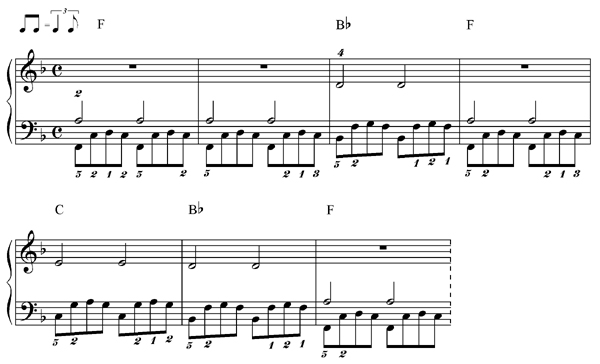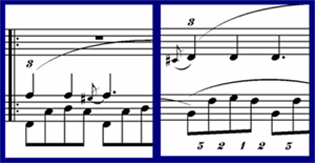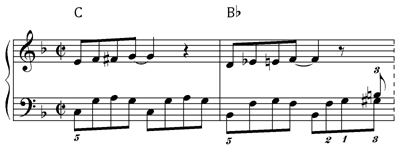Musicarta Twelve-bar Piano Styles
The Cowboy Roll
The Cowboy Roll is a twelve-bar in the key of F, so the three chords it will use are F, B¨ and C. Here is the chord chart.

Your piano solo has a two-bar introduction,
and the music isn’t set out on three neat lines like this neat chord chart, but
the pattern’s still there. Identify it in the music and expect to hear it as you listen to the performance audio (under this video, with the MIDI reference).
Triplet feel - a reminder
 |
Above the first line of music, you see the ‘swing quavers’ graphic (shown left) indicating that the quavers, although written ‘straight’, are a long one and a short one. Combined with the open-textured left hand, this gives the solo it’s riding-along cowboy feel. |
Practice the left hand
The left hand uses the typical boogie root, fifth and sixth tones, but in a very open texture. Here’s a preliminary exercise. You might not be able to get the last quaver before the chord change – it’s preferable to sacrifice a quaver and get to the new chord on time! Add the third in the right hand when you are able.

Notice how the exercise practices the jumps between chords – F to B¨ and back to F, and F to C and to B¨ and back to F. (It’s usually difficulty with the jumps that hold a performance back.) Notice also how the fingering tries to make things easier by anticipating the new hand position.
The MIDI file is cropped to repeat at a play-along practice tempo.
Two- hand practice segments
The swing quavers plus the syncopation make playing this simple-looking piece quite a challenge. The following are the fragments you’ll probably need to practice.

Where you see all the notes on one clef like this, the stems-up notes are right hand, the stems-down are left hand.
This written-out practicing helps you identify the pairs of left hand-plus-right hand notes and just go over them until they ‘feel right’. You can abandon the rhythm altogether to start with – slow the looped MidiPiano performance right down until you can follow.
In other places, the same three right hand notes play over a different part of the left hand accompaniment.

Here’s a practice segment for another typically difficult patch.

In performance, this practice segment is followed by the one immediately above (as shown in the MIDI.
Crushed notes
Twelve-bar music often has some ‘crushed notes’. Most often, you crush
|
the note a semitone below the third of the chord, so in F bars you will find the G sharp crushed up against the A, and the C sharp up against the D in B flat bars. |
 |
The chromatic thirds
You have just finished studying chromatic thirds. You solve the challenge in bars 13 and 14 in two ways:
- By knowing exactly which keys on the keyboard to play, and
- By knowing what fingering you will use.
It can also be useful to notice that:
- In the C bar (bar 13), there are three all-white pairs and one all-black pair.
- In the B flat bar, there are three one white key, one black key pairs and one all-white pair.
Work out what this means, and you’re half way there!
As a temporary measure, you could play just the top line of notes:

One last tip! In bar 15 – the two-handed thirds in F – expect your hands to rub against each other. Some pianists find this an odd feeling, but it isn’t ‘wrong’.
|
OUT NOW! |
THE MUSICARTA BEAT & RHYTHM WORKBOOK At last! An effective approach to keyboard rhythm & syncopation skills. Learn more! |
ONLY $24.95! |
The MusicartaA methodical approach to keyboard syncopation for
|
PUBLICATIONS
exciting keyboard
creativity courses
CHORDS 101
WORKBOOK

~HANON~
video course

Musicarta
Patreon
PENTATONICS
WORKBOOK
video course

Creative Keyboard
video course

BEAT AND RHYTHM
WORKBOOK

- Volume 1 -

12-BAR PIANO
STYLES WORKBOOK

MUSICARTA MODES
WORKBOOK

PIANO STYLE

CANON PROJECT
video course

VARIATIONS
video course


- Piano Solo -
video course

- Piano Solo -


YouTube playlists





 THE LOGO
THE LOGO
